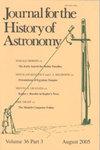Clive Ruggles的节日庆典
IF 0.3
3区 哲学
Q3 HISTORY & PHILOSOPHY OF SCIENCE
引用次数: 0
摘要
不是通过这篇文章本身的翻译,而是通过两个附录的翻译,对应于Trutina Hermetis和De comtis。不幸的是,这个版本提供的注释比Rinaldi的少,也没有那么丰富,没有附录和术语表。所有这些迹象都表明,卡尔加诺的工作,特别是在语言学上,远不如里纳尔迪的彻底和严谨,里纳尔迪是意大利文艺复兴时期占星术和人文主义版本的公认专家,他为这本伏尔加尼扎门托的版本工作了很长时间。此外,Rinaldi指出(第136页,第34页),MS Magliabech。XX.22当然非常接近拉丁语模式,这可能启发了这个意大利语翻译(正如许多共同的教训和错误所证明的那样),但不一定是它的直接来源,与Calcagno的说法相反(第36-43页)。这并没有减损《中央公报》的伏尔加利扎曼托的显著兴趣。事实上,主要是在意大利,有一种丰富的手抄本传统,在柏拉图的Tivoli版本的拉丁文文本的边缘注释,从13世纪一直持续到15世纪末,旨在解释文本的含义以及它所包含的阿拉伯语的音译,这一传统可能要追溯到克雷莫纳的Gerard和他的同伴(Stefan Georges, Seb Falk和Emanuele Rovati目前正在研究这个话题),1484年和1493年在威尼斯出版的古奴布拉版本中仍然可以找到这些痕迹。像其他十份拉丁文手稿一样,这种注释传统被保留了下来,BNC的两份佛罗伦萨抄本,Magliabech。XX.22和Palatino 641,是中世纪最后几个世纪和文艺复兴时期意大利占星文化适应的深度和复杂性的见证,这种文化适应比当时其他欧洲国家更好地传播给了非专业精英。本文章由计算机程序翻译,如有差异,请以英文原文为准。
A Festschrift for Clive Ruggles
Centiloquium, not by the translation of this text itself, but by that of the two appendices corresponding to the Trutina Hermetis and the De cometis. Unfortunately, this edition offers fewer and less rich notes than does Rinaldi’s and includes no appendix and no glossary. All these indications suggest that Calcagno’s work is much less thorough and scrupulous, especially philologically, than that of Rinaldi, an acknowledged specialist in Italian Renaissance astrology and the humanist versions of the Centiloquium who worked for a long time on the edition of this volgarizzamento. Moreover, Rinaldi shows (p. 136, n. 34) that the MS Magliabech. XX.22 is certainly very close to the Latin model which could have inspired this Italian translation (as attested by many common lessons and errors) but is not necessarily its direct source, contrary to what Calcagno claims (pp. 36–43). This does not detract from the remarkable interest of this volgarizzamento of the Centiloquium. It is in fact mainly in Italy that a rich manuscript tradition of marginal annotations to the Latin text in Plato of Tivoli’s version continued from the 13th to the end of the 15th century, intended to explain the meaning of the text and of the transliterations from the Arabic it contains, a tradition that perhaps goes back to Gerard of Cremona and his companions (Stefan Georges, Seb Falk and Emanuele Rovati are presently working on this topic), and of which traces can still be found in the incunabula editions published in Venice in 1484 and in 1493. Like about 10 other Latin manuscripts where this tradition of glosses is preserved, the two Florentine codices of the BNC, Magliabech. XX.22 and Palatino 641, are witnesses to the depth and sophistication of astrological acculturation in Italy in the last centuries of the Middle Ages and the Renaissance, an acculturation better transmitted to the lay elites than in other European countries at that time.
求助全文
通过发布文献求助,成功后即可免费获取论文全文。
去求助
来源期刊

Journal for the History of Astronomy
地学天文-科学史与科学哲学
CiteScore
0.50
自引率
25.00%
发文量
44
审稿时长
>12 weeks
期刊介绍:
Science History Publications Ltd is an academic publishing company established in 1971 and based in Cambridge, England. We specialize in journals in history of science and in particular history of astronomy.
 求助内容:
求助内容: 应助结果提醒方式:
应助结果提醒方式:


